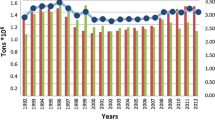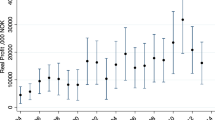Abstract
Global marine capture fisheries are undergoing serious stress, with overfishing as one of the major problems. In order to mitigate the overexploitation of capture fisheries, government regulation or fisheries management is necessary. Among various management approaches, vessel quantity control is being widely employed. To achieve effective governance of fisheries, the technical efficiency (TE) issue needs to be considered in the implementation of vessel quantity control. Using the Pacific saury (Cololabis saira) stick-held dip net fishery in Japan as a case study, this paper estimated the TE of sampled fishing vessels and explored the possible factors affecting the gap in efficiency. This paper aims to provide suggestions for a better implementation of vessel quantity control in global Pacific saury fishery, and also to serve as an empirical example of integrating TE analysis into management of overexploited fisheries for achieving satisfactory effects. Results show the TE score of the sampled fishery averaged around 0.7 from 2009 to 2014, and factors concerning owners/skippers’ motivation such as vessel ownership and specialization, vessel tonnage as well as skippers’ age show positive effects on the TE. Our findings in the present work provide important strategies for mitigating overexploitation in fisheries. Conducting technical efficiency analysis of targeted fisheries is a vital issue to be considered for designing and realizing an effective implementation of fisheries management approaches. The large vessels and the enthusiasm of vessel owners/skippers need to be particularly addressed when vessel quantity limit is considered to mitigate the problem of overfishing.


Similar content being viewed by others
References
Aigner D, Lovell CAK, Schmidt P (1977) Formulation and estimation of stochastic frontier production function models. J Econ 6(1):21–37
Årland K, Bjørndal T (2002) Fisheries management in Norway—an overview. Mar Policy 26(4):307–313
Anderson R, Fish M, Xia Y, Michello F (1999) Measuring efficiency in the hotel industry: a stochastic frontier approach. Int J Hosp Manag 18(1):45–57
Battese GE (1992) Frontier production functions and technical efficiency: a survey of empirical applications in agricultural economics. Agric Econ 7(3):185–208
Battese GE, Coelli TJ (1995) A model for technical inefficiency effects in a stochastic frontier production function for panel data. Empir Econ 20:325–332
Battese GE, Heshmati A, Hjalmarsson L (2000) Efficiency of labour use in the Swedish banking industry: a stochastic frontier approach. Empir Econ 25(4):623–640
Beddington JR, Agnew DJ, Clark CW (2007) Current problems in the management of marine fisheries. Science 316(5832):1713–1716
Caddy JF, Cochrane KL (2001) A review of fisheries management past and present and some future perspectives for the third millennium. Ocean Coast Manag 44(9):653–682
Campbell HF, Hand AJ (1998) Joint ventures and technology transfer: the Solomon Islands pole-and-line fishery. J Dev Econ 57:421–442
Charles AT (1997) Fisheries management in Atlantic Canada. Ocean Coast Manag 35(2):101–119
Coelli TJ (1995) Estimators and hypothesis tests for a stochastic frontier function: a Monte Carlo analysis. J Prod Anal 6:247–268
Coelli TJ, Rao DSP, O'Donnell CJ, Battese GE (2005) An introduction to efficiency and productivity analysis. Springer, New York
Cunningham S, Whitmarsh D (1980) Fishing effort and fishing policy. Mar Policy 5:309–316
Cunningham S, Bostock T (eds) (2005) Successful fisheries management: issues, case studies and perspectives. Eburon Academic Publishers, Delft, the Netherlands
del Hoyo JJG, Espino DC, Toribio RJ (2004) Determination of technical efficiency of fisheries by stochastic frontier models: a case on the Gulf of Cadiz (Spain). ICES J Mar Sci: J Conseil 61:416–421
Esmaeili A (2006) Technical efficiency analysis for the Iranian fishery in the Persian Gulf. ICES J Mar Sci: J Conseil 63:1759–1764
Food and Agriculture Organization (2014) The state of world fisheries and aquaculture. http://www.fao.org/3/a-i3720e.pdf Cited 15 May 2016
Farrell MJ (1957) The measurement of productive efficiency. J Royal Stat Soc Ser A (General) 120:253–290
Felthoven RG (2002) Effects of the American Fisheries Act on capacity, utilization and technical efficiency. Mar Resour Econ 17(3):181–205
Fisheries Research Agency of Japan (2014) Stock assessment of the Northwest subpopulation of Pacific saury. http://abchan.fra.go.jp/digests26/details/2609.pdf Cited 12 Nov 2015 (in Japanese)
Fousekis P, Klonaris S (2003) Technical efficiency determinants for fisheries: a study of trammel netters in Greece. Fish Res 63(1):85–95
Japanese Fisheries Agency (2015) http://www.jfa.maff.go.jp/j/press/kokusai/150903.html. Accessed 12 Oct 2015a (in Japanese)
Japanese Fisheries Agency (2016) Name list of the permitted Pacific saury vessels managed by MAFF. http://www.jfa.maff.go.jp/j/kikaku/sitei/pdf/sanma2016.pdf. Accessed 23 Nov 2015b (in Japanese)
Hannesson R (1983) Bioeconomic production function in fisheries: theoretical and empirical analysis. Can J Fish Aquat Sci 40(7):968–982
Holden ST, Bezabih M (2008) Gender and land productivity on rented land in Ethiopia. In: Holden ST, Otsuka K, Place FM (eds) The emergence of land markets in Africa: impacts on poverty, equity and efficiency. Resources for the Future, Washington
Huang WB, Huang YC (2015) Maturity characteristics of Pacific saury during fishing season in the northwest pacific. J Mar Sci Technol (Taiwan) 23(5):819–826
Kalirajan KP, Tse YK (1989) Technical efficiency measures for the Malaysian food manufacturing industry. Dev Econ 27(2):174–184
Kim DH, Lee KH, Bae BS, Park SW (2011) Productive efficiency of the sandfish Arctoscopus japonicus coastal gillnet fishery using stochastic frontier analysis. Fish Sci 77(1):35–40
Kirkley JE, Squires D, Strand IE (1995) Assessing technical efficiency in commercial fisheries: the mid-Atlantic Sea scallop fishery. Am J Agric Econ 77(3):686–697
Kirkley JE, Squires D, Strand IE (1998) Characterizing managerial skill and technical efficiency in a fishery. J Prod Anal 9(2):145–160
Kompas T, Che TN, Grafton RQ (2004) Technical efficiency effects of input controls: evidence from Australia's banana prawn fishery. Appl Econ 36(15):1631–1641
Makino M (2011) Fisheries management in Japan: its institutional features and case studies. Springer, New York
McPhee D (2008) Fisheries management in Australia. Federation Press, Sydney
Meeusen W, van den Broeck J (1977) Efficiency estimation from cobb-Douglas production functions with composed error. Int Econ Rev 18(2):435–444
Ministry of Agriculture, Forestry and Fisheries of Japan (2012) Annual statistics of fishery and fish culture. http://www.e-stat.go.jp/SG1/estat/List.do?lid=000001129478 Cited 5 Nov 2015a
Ministry of Agriculture, Forestry and Fisheries of Japan (2013) Annual statistics of fishery and fish culture. http://www.e-stat.go.jp/SG1/estat/List.do?lid=000001129478 Cited 10 Dec 2015b
North Pacific Fisheries Commission. http://nwpbfo.nomaki.jp Cited 15 Dec 2015
Pascoe S, Andersen JL, de Wilde JW (2001) The impact of management regulation on the technical efficiency of vessels in the Dutch beam trawl fishery. Eur Rev Agric Econ 28(2):187–206
Pascoe S, Coglan L (2002) The contribution of unmeasurable inputs to fisheries production: an analysis of technical efficiency of fishing vessels in the English Channel. Am J Agric Econ 84(3):585–597
Sakai Y, Mori K, Yagi N (2012) The technical efficiency analysis for Japanese fishery: the case for the offshore bottom trawl fishery in Hokkaido. J Int Fish 11:101–119 (in Japanese with English abstract)
Sharma KR, Leung PS (1998) Technical efficiency of the longline fishery in Hawaii: an application of a stochastic production frontier. Mar Resour Econ 13(4):259–274
Shen G, Heino M (2014) An overview of marine fisheries management in China. Mar Policy 44:265–272
Squires D, Grafton RQ, Alam MF, Omar IH (2003) Technical efficiency in the Malaysian gill net artisanal fishery. Environ Dev Econ 8(03):481–504
Tingley D, Pascoe S, Coglan L (2005) Factors affecting technical efficiency in fisheries: stochastic production frontier versus data envelopment analysis approaches. Fish Res 73(3):363–376
Watanabe Y, Butler JL, Mori T (1988) Growth of Pacific saury, Cololabis saira, in the northeastern and northwestern Pacific Ocean. Fish Bull 86(3):489–498
Waldo S (2006) Capacity and Efficiency in Swedish Pelagic Fisheries IDEMA/SLI Working Paper No. 2006:1. Lund: Swedish Institute for Food and Agricultural Economics
Yantai Daily Newspaper (2015). Jinglu Fisheries Company caught 280,000 tonnes of Pacific saury in 2014. http://www.shm.com.cn/ytrb/html/2015-01/30/content_3076643.htm Cited 18 Dec 2015 (in Chinese)
Acknowledgments
The authors express their sincere thanks to the staff of the Habomai Fisheries Cooperative Association for providing the valuable data and information. We would like to thank the China Scholarship Council (CSC) for providing the scholarship to the first author.
Author information
Authors and Affiliations
Corresponding author
Rights and permissions
About this article
Cite this article
Yang, C., Lou, X., Matsui, T. et al. Evaluating the technical efficiencies of fishing vessels to achieve effective management of overexploited fisheries. Mitig Adapt Strateg Glob Change 22, 1149–1162 (2017). https://doi.org/10.1007/s11027-016-9719-7
Received:
Accepted:
Published:
Issue Date:
DOI: https://doi.org/10.1007/s11027-016-9719-7




